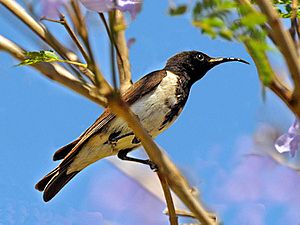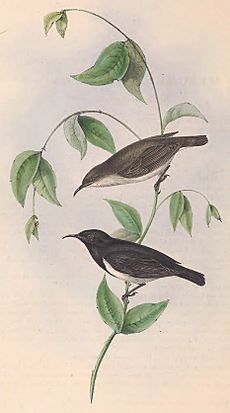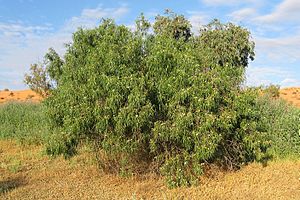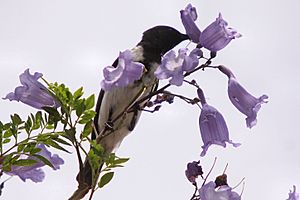Black honeyeater facts for kids
Quick facts for kids Black honeyeater |
|
|---|---|
 |
|
| A male on a Jacaranda | |
| Conservation status | |
| Scientific classification | |
 |
|
| Approximate distribution of the black honeyeater | |
| Synonyms | |
|
The black honeyeater (Sugomel niger) is a small bird found only in Australia. It belongs to the honeyeater family called Meliphagidae. This bird is special because it's the only species in its group, Sugomel.
Black honeyeaters look different depending on if they are male or female. Males are black and white, while females are speckled grey-brown. Young birds look like the females. These birds live in dry parts of Australia, often in open woodlands and shrublands. They especially like areas where emu bushes grow.
Black honeyeaters mostly eat nectar from flowers. They have a long, curved beak that helps them reach the nectar deep inside tube-shaped flowers, like those of the emu bush. They also catch insects in the air. Interestingly, they sometimes eat ash from campfires! They build cup-shaped nests in small trees or shrubs.
During mating season, the male black honeyeater performs a special soaring flight and sings. However, the female does most of the work building the nest and sitting on the eggs. Both parents help feed and care for the young birds. Even though their numbers seem to be going down, there are still many black honeyeaters around. Because of this, they are listed as a species of least concern by the IUCN.
Contents
About the Black Honeyeater
What's in a Name?
The black honeyeater was first described in 1838 by an English naturalist named John Gould. He called it Myzomela nigra. The word nigra is Latin for 'black'. The name Myzomela comes from Ancient Greek words meaning 'to suckle' and 'honey'. This name describes how the bird drinks nectar.
Later, in 1922, another expert, Gregory Mathews, gave the bird its own special group called Sugomel. This name also means 'suck honey' in Latin.
Scientists have studied the bird's DNA to learn more about its family tree. These studies showed that the black honeyeater is quite unique. It's related to other honeyeaters but is different enough to have its own group. Today, its official scientific name is Sugomel niger.
The black honeyeater is sometimes called the "charcoal bird." This is because it likes to collect ashes from old campfires.
How to Spot Them
The black honeyeater is a small bird, usually about 10 to 13 centimeters (4 to 5 inches) long. It has a wingspan of about 19 centimeters (7.5 inches) and weighs around 9.5 grams (0.3 ounces). It has a long, thin, curved beak. Its head is small and round, and its body is plump.
Males and females look very different:
- Males: They have a black head, neck, wings, and upper body. A black stripe runs down their chest to their belly. Their belly, sides, and under-tail feathers are white.
- Females: Their head and upper parts are buff-brown with lighter scalloped patterns. They have a pale eyebrow. Their chest is speckled grey-brown, fading to a dull white belly.
Young birds look similar to adult females. Both males and females have dark brown eyes and blackish-brown beaks and legs.
What Do They Sound Like?
Black honeyeaters are usually quiet when it's not breeding season. But when they are ready to nest, they make different calls. These calls often happen early in the morning.
Some of their calls include:
- A soft, metallic "chwit, chwit."
- A louder, even-pitched "tieee" sound, repeated every few seconds.
- A weak "peeee" sound, often made by males during breeding.
After the chicks hatch, both parents make a soft scolding call. This might be a way to tell the young that food is coming. They also make a bill-snapping sound when catching insects in the air.
These birds are always moving. They hover around flowers to feed and chase away other birds from their food sources.
Where They Live
The black honeyeater lives in the dry inland parts of Australia. You can find them across western Queensland and New South Wales, and into South Australia. They are also common in central and northern Western Australia. Sometimes, they are seen in the Northern Territory, especially around Alice Springs.
These birds depend a lot on the berrigan emu bush and similar plants. So, they live in open woodlands and shrublands in dry and semi-dry areas. They are also found in mulga or mallee woodlands. Sometimes, they live in spinifex grasslands where flowering shrubs like grevilleas and paperbarks grow. It's amazing how they can find emu bushes, even if there are only a few plants spread far apart. This shows how important these plants are to them.
Black honeyeaters are considered migratory birds. This means they move around regularly with the seasons. Their movements are linked to when their food plants, especially the emu bush, are flowering. They often move south in the Australian spring and summer. Then, they head north again in autumn and winter. During very dry times, they might be seen in areas where they don't usually go. If there's a lot of rain or floods, their numbers can suddenly increase in some areas.
How They Behave
Black honeyeaters are usually seen alone or in pairs. However, if there are many flowering plants, up to 50 birds might gather together.
Breeding and Nests
The breeding season for black honeyeaters is usually from July to December. But they can also breed at other times if there has been rain. Birds in Western Australia might nest earlier than those in Queensland. Black honeyeaters gather to breed where there are plenty of flowering plants and insects. Both are important for feeding their young.
At the start of the mating season, males perform special "song flights." They fly high into the air in a zigzag pattern, singing constantly. They seem to stiffen their bodies with wings pointing down as they rise, making a two-note call.
Black honeyeaters form loose groups during breeding season. Only a few pairs within the group will actually breed. Males protect a small area from other black honeyeaters and other types of honeyeaters. Both the male and female choose the nest spot.
The nest is usually built low down on a dead branch or in the fork of a small tree or shrub. Sometimes, they even choose fallen wood. The female collects materials close to the nest site. She builds a shallow, open, cup-shaped nest. She uses fine twigs, grass, and other plant bits, holding them together with spiderweb. She lines the nest with soft materials like grass, roots, hair, or wool. As the chicks grow, the nest can flatten out.
The female lays two to three eggs. They are about 15 millimeters (0.6 inches) long and 12 millimeters (0.5 inches) wide. The eggs are shiny and buffy white. They have reddish-brown and grey spots, often clustered at the wider end. Sometimes, another bird called Horsfield's bronze cuckoo lays its eggs in a black honeyeater's nest.
The female sits on the eggs alone. She leaves the nest for short times during the day to catch insects. If someone gets too close to the nest, she tries to hide. If that doesn't work, she might fall to the ground with her wings spread, making weak calls. This is to trick the intruder into following her away from the nest. While the female is on the nest, the male watches from a nearby spot.
The eggs hatch after about 16 days. The chicks are born with their eyes closed and no feathers, only some soft down on their head and back. Both parents feed and care for the young. They catch insects in the air for the chicks. At one nest, two small chicks were fed every ten minutes. The male brought food much more often than the female. After the young birds can fly, the whole family leaves the nesting area within a few days.
What They Eat
Black honeyeaters mainly eat nectar. They use their long, thin beak to find nectar in flowers and leaves. They are often seen in the tops of eucalypt trees, around clumps of mistletoe, or in shrubs, especially emu bushes.
Studies in South Australia showed black honeyeaters visiting flowers of berrigan emu bush, twin-leaf emu bush, lerp mallee, and holly grevillea. They also often catch small insects while flying. Black honeyeaters hover around flowers, quickly feeding at each one. They sometimes join large groups of other birds, like pied honeyeaters, to feed. Like many honeyeaters, they are good at catching insects in mid-air. The male especially flies up to 15 meters (50 feet) high to grab an insect, then returns to a favorite perch.
A fascinating thing about black honeyeaters is that breeding females have been seen eating ash from campfires. They often visit the fire many times over a short period. It looks like "bees buzzing around a honeypot." After pecking at the ash, some females hunt for insects nearby. Then they return for more ash. Males sometimes land near the fire but are not seen eating ash.
Scientists think that the females eat ash because it's rich in calcium. They might need this calcium to form their eggs or to recover calcium after laying eggs. Other small birds, like hummingbirds, also eat calcium-rich ash, bones, or shells. This suggests that small birds might not be able to store enough calcium in their bones for egg production.
Protecting the Black Honeyeater
The number of black honeyeaters seems to be going down. However, this decline is not happening very quickly. There are still enough of them, and they live across a large area. Because of this, the IUCN lists them as a species of least concern. This means they are not currently in danger of extinction.
However, some scientists have noticed that the black honeyeaters' living area in inland Australia shrank after years of low rainfall. Even after several years, their numbers did not fully recover. These scientists point out that birds that move around a lot, like the black honeyeater, might have a large range. But they often need very specific habitats. This means they might only use a small part of their large range. So, the risk of these species disappearing might be underestimated.
The black honeyeater could be harmed if the emu bush, which it relies on, disappears. This can happen because of animals eating the plants or farmers removing weeds.
See also
 In Spanish: Mielero blanquinegro para niños
In Spanish: Mielero blanquinegro para niños





